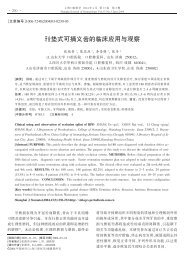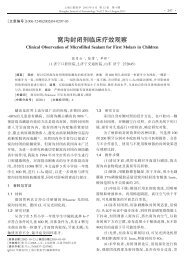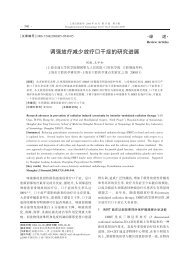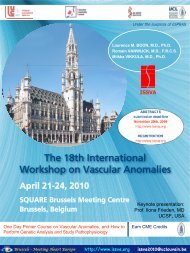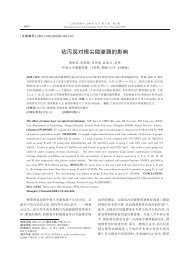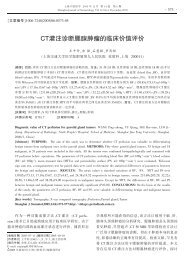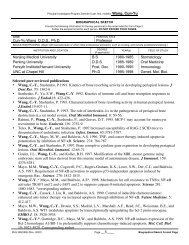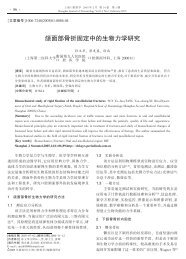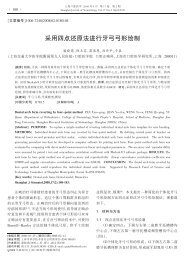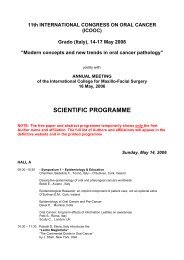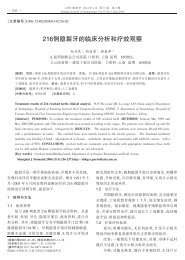core curriculum cleft lip/palate craniofacial anomalies
core curriculum cleft lip/palate craniofacial anomalies
core curriculum cleft lip/palate craniofacial anomalies
Create successful ePaper yourself
Turn your PDF publications into a flip-book with our unique Google optimized e-Paper software.
Core Curriculum for Cleft Palate and other Craniofacial Anomalies<br />
C. Infant: This is the typical time when surgical closure of the <strong>lip</strong> and <strong>palate</strong><br />
is accomplished.<br />
1. Cleft <strong>lip</strong> is usually surgically closed in the first 2 to 3 months of life when it is<br />
clear that the baby is healthy and thriving. Most surgeons still use the rule of<br />
tens to plan the timing of closure.<br />
a. Ten weeks.<br />
b. Ten pounds.<br />
c. Hemoglobin of ten.<br />
2. Some surgeons perform <strong>lip</strong> adhesion prior to definitive <strong>lip</strong> repair. This<br />
procedure is a partial <strong>lip</strong> repair that does not rearrange the structures into<br />
normal anatomic position. Its purpose is to narrow the <strong>cleft</strong> making the final<br />
<strong>lip</strong> repair easier.<br />
3. The goal of the <strong>lip</strong> closure is to create a <strong>lip</strong> that functions well and<br />
approximates the physical characteristics associated with a non-<strong>cleft</strong> <strong>lip</strong>. The<br />
physical characteristics of the nose will also be improved by the <strong>lip</strong> closure.<br />
Sometimes <strong>lip</strong> revision will be required to improve the result, but the first<br />
operation generally provides a dramatic and lasting improvement in the<br />
function and appearance of the baby’s <strong>lip</strong>.<br />
4. The timing of <strong>palate</strong> closure varies from team to team but is usually<br />
carried out from 6 months to 18 months of age.<br />
5. In children with airway problems or extremely wide palatal <strong>cleft</strong>s, closure<br />
may be delayed.<br />
6. The reason to close the <strong>palate</strong> is so that speech will develop normally and<br />
the patient will not regurgitate liquids and solids into the nose when eating.<br />
7. Every sound in the English language except M, N, and NG resonates<br />
orally.<br />
8. When a <strong>palate</strong> and <strong>cleft</strong> is not closed, resonance is hypernasal and multiple<br />
errors in speech development will occur.<br />
D. Toddler<br />
1. Despite closure of the palatal <strong>cleft</strong>, many children with <strong>cleft</strong> <strong>palate</strong> will<br />
still require speech therapy and approximately 10 to 20 percent may require<br />
secondary surgery for persistent hypernasal speech after closure.<br />
a. This is called velopharyngeal insufficiency (VPI).<br />
b. VPI becomes evident at age 2 to 3.<br />
c. Rarely can occur without <strong>cleft</strong> <strong>palate</strong>.<br />
d. Secondary surgical procedures to correct this problem are<br />
1) Posterior pharyngeal flap<br />
2) Pharyngoplasty<br />
3) Augmentation of the posterior pharyngeal wall<br />
4) Speech prosthesis<br />
e. See Speech Language Pathology section for more details on<br />
evaluation.<br />
24<br />
© 2004 American Cleft Palate-Craniofacial Association



